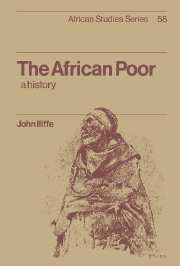Book contents
- Frontmatter
- Contents
- Preface
- 1 The comparative history of the poor
- 2 Christian Ethiopia
- 3 The Islamic tradition
- 4 Poverty and power
- 5 Poverty and pastoralism
- 6 Yoruba and Igbo
- 7 Early European initiatives
- 8 Poverty in South Africa, 1886–1948
- 9 Rural poverty in colonial Africa
- 10 Urban poverty in tropical Africa
- 11 The care of the poor in colonial Africa
- 12 Leprosy
- 13 The growth of poverty in independent Africa
- 14 The transformation of poverty in southern Africa
- Notes
- Bibliography
- Index
13 - The growth of poverty in independent Africa
Published online by Cambridge University Press: 31 October 2009
- Frontmatter
- Contents
- Preface
- 1 The comparative history of the poor
- 2 Christian Ethiopia
- 3 The Islamic tradition
- 4 Poverty and power
- 5 Poverty and pastoralism
- 6 Yoruba and Igbo
- 7 Early European initiatives
- 8 Poverty in South Africa, 1886–1948
- 9 Rural poverty in colonial Africa
- 10 Urban poverty in tropical Africa
- 11 The care of the poor in colonial Africa
- 12 Leprosy
- 13 The growth of poverty in independent Africa
- 14 The transformation of poverty in southern Africa
- Notes
- Bibliography
- Index
Summary
Those fighting poverty in tropical Africa during the 1980s shared the mixed disillusionment and hope of leprosy workers. The bad news was that after relative prosperity during the 1960s, Africa suffered economic crisis during the later 1970s and its very poor people increased in number. As in the colonial period, structural poverty changed less than conjunctural poverty. The incapacitated, the aged, unsupported women, and the young were still the bulk of the structural poor. They were supplemented by the new poor of the twentieth century – inhabitants of neglected regions, the unemployed, and especially the ill paid – and by growing numbers who, although able-bodied, were barred from resources by the competition of a growing population or by a more ruthless use of power and wealth. Yet structural poverty remained a cumulative phenomenon and only a minority of the African poor were yet landless, in contrast to their Asian or Latin American counterparts. Conjunctural poverty, by contrast, showed more discontinuity with the colonial period, especially in the return of mass famine mortality after nearly half a century. This in turn brought important changes in the care of the poor.
The good news was of two kinds. On the one hand, the crises of the 1970s and 1980s showed that the poor had lost little of their resilience and capacity for survival. On the other hand, awareness of African poverty grew rapidly at that time. It was realised at last that the poor were mainly rural. It was realised, too, that earlier public policies had contributed to poverty.
- Type
- Chapter
- Information
- The African PoorA History, pp. 230 - 259Publisher: Cambridge University PressPrint publication year: 1987



